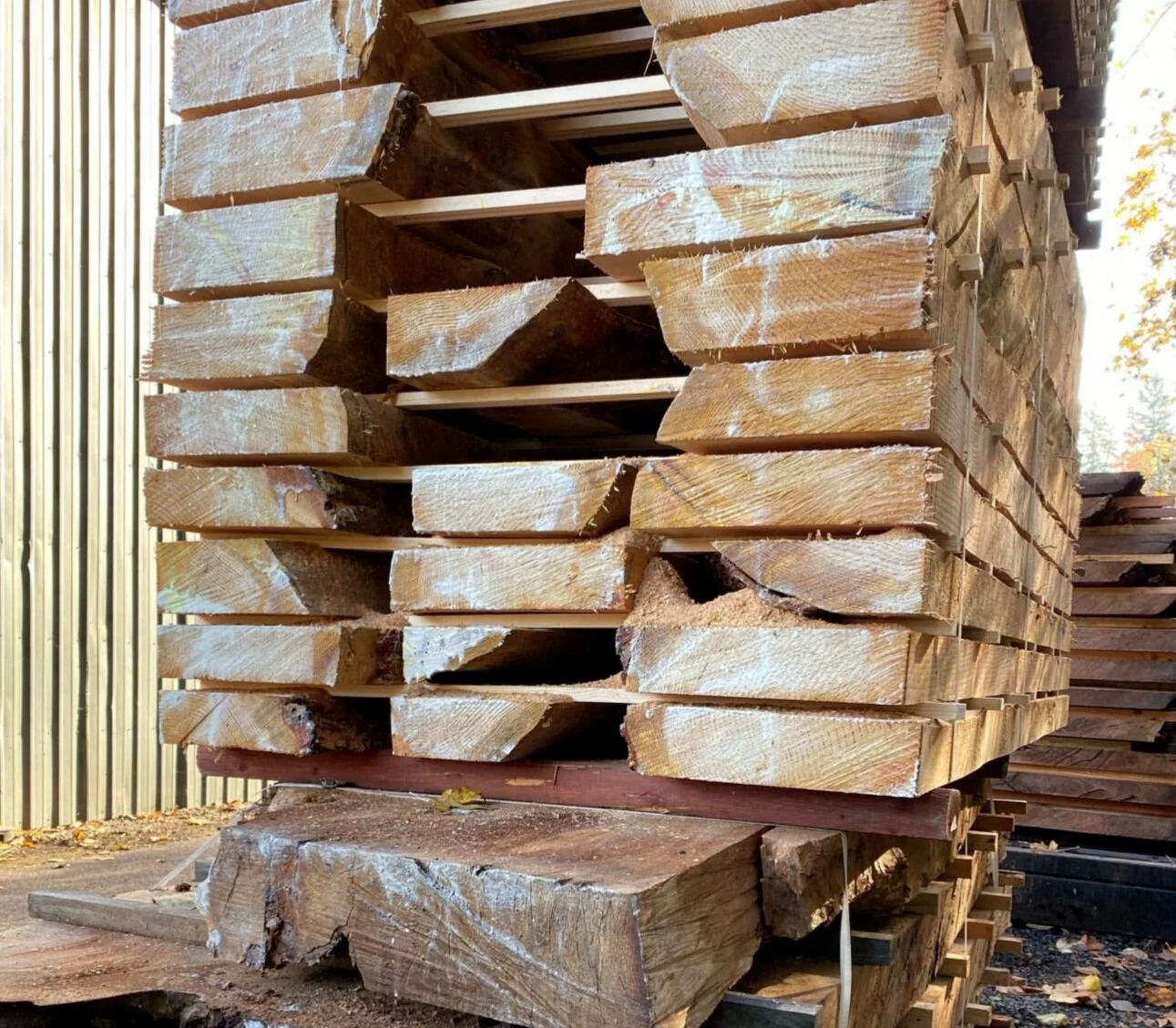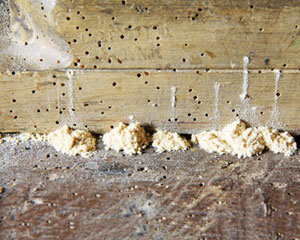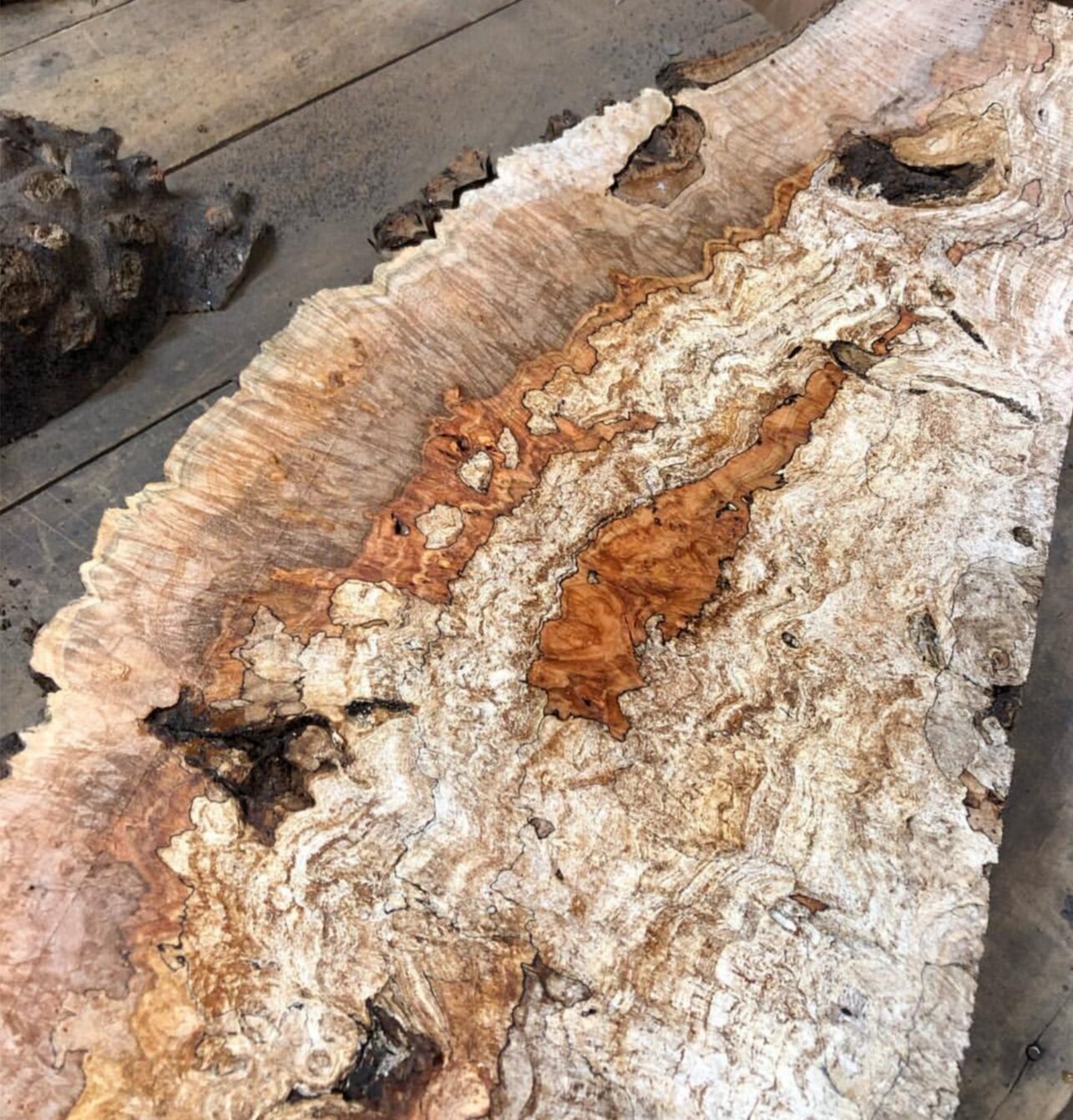Live Edge Wood For Beginners - Part One - Green Wood, Wood Bugs, and Wood Rot
Live edge is a seemingly modern trend that has actually been around for a long time. Most attribute the live edge movement to George Nakashima. Nakashima was a Japanese-American architect and woodworker who made gorgeous live edge tables back at least as far as the early 60’s. While Nakashima brought popularity to the natural edge movement, it would be hard to say he was actually the first in human history to fashion a table with two natural edges. And as far as I know, Nakashima never made that claim.
About as easy as a live edge table gets here
I think part of the allure of the live edge table to DIYers like you and me is that it not only looks super cool, but appears to be pretty easy. It looks like you get a slab, put some finish on it, bolt some legs on, and you may be finished in time for dinner!… Unfortunately we all find out sooner or later that live edge tables can present some unusual challenges we may have overlooked. All of these challenges can be overcame with a little bit of knowledge and work, but not knowing what you don’t know is by far the biggest problem. So this blog is going to be everything you need to know about what makes an acceptable slab to start your project. Specifically, we are going to discuss how dry your wood needs to be, what defects to look for, and what to do about any bugs that may be living inside.
Wet Wood
Green wood drying with the ends waxed
Before you start shopping for wood, you need to know a couple things first. The most important thing to know is, is it dry? You DO NOT want to work with wet wood. Also referred to as green wood. The wood will warp and twist as it dries, so you need the wood to be at equilibrium before you start working on it. The definition of dry wood varies by the part of your country you are in. Dry is actually not the most accurate term. A more accurate term would be “has it reached equilibrium moisture content (EMC)?” However you should know, nobody says that, and “dry” is still the expression we have. All that EMC means is the percentage of water left in a piece of wood when it reaches equilibrium. Either through air drying or kiln drying. Meaning, all wood will have some moisture left in it. No matter how long it sits. EMC varies by region, Oregon is around 9%, Arizona is around 6%, and a humid area like Florida is around 12%. For comparison, a fresh cut walnut tree might have moisture content (MC) of 60%. A slab sitting for a year or two might still have a MC of 30% or more.
So how do you know if a slab is dry? There is really only one good answer, and that is to use a moisture meter (more on these below). I used to follow the old rule of “one inch per year” to air dry. Meaning, if you had a two inch thick slab, you could set it out of the elements and it would air dry in two years. I really wanted to believe that rule. I even bought some air dried slabs from a very dry part of Eastern Oregon. Turns out that rule can be true, but more often that not, it isn’t a good rule to follow. Those eastern Oregon slabs have now been drying for six years and still have areas of moisture of over 30%.
Pinless meter on bottom reading much more accurately than the pin meter on top.
When is comes to moisture meters, they are not all created equally. You can buy a cheap one on amazon for around $25. These are usually “pin meters”. Which tell the MC by inserting two sharp pins into your wood about 1/16th of an inch. The problem with these is pretty self evident. First, they only tell the MC of the outer 1/16th of an inch of your slab. And second, they put little holes in your piece.
The alternative to a pin meter is a pinless meter. Which will tell you the MC of a piece of wood up to 3/4” down inside the wood. Not just on the surface. It does this by sending frequencies into the wood to get the MC, so it leaves absolutely no marks. The new best of the best moisture meters from Wagner actually have whole bevy of additional features as well. In addition to giving MC, they will also give you the exact EMC of your living room (for example). So you know just how dry your wood needs to be at equilibrium. No estimating. The downside of these is they cost anywhere from $380 to $540. Which is understandably out of reach for your average DIYer. I should also note that cheaper pinless meters are available. I have owned them, and unfortunately cannot recommend them. I say get a good Wagner, or a cheap pin meter. The pin meters are at least accurate in that outer 1/16th inch.
If you are like me and build a table or more every month. Then a pinless meter is just a necessary tool to own. And if you don’t own one, its time you did. However if you are part of the other 99%, $500 is way too much to spend for a one-off coffee table project. The good news is, any reputable slab supplier will own one of these pinless meters. So just ask to borrow theirs. If they don’t own one, think hard about purchasing wood from them. Even most of the unreputable dealers I’ve dealt with have a good Wagner meter.
When you use the pinless meter, be sure to check all over the slab. Not just in one spot. It is very common for moisture to become trapped in isolated ares of the slab. Those pockets can sink or warp as your slab continues to dry. Ruining your perfect project a few months after finishing. So just run your meter over the entire slab, front and back. Don’t be too concerned if it varies by 1-3%. If one spot is 8% and another is 10-11%, your slab is fine. However if you find much more variation than that, maybe consider a different slab.
Your Wood Has Bugs in it
Sawdust piles are the first sign of wood bug damage.
Now that you know you need good dry wood that has either air dried to EMC, or has been kiln dried to your EMC. You need to figure out what to do about the bugs inside of it. Little beetles live inside of lots of trees. They can lay dormant for years, eventually crawling out of a finished table leaving tiny holes and little piles of sawdust to let you know they are there. There is no way to know if your slab definitely does or doesn’t have living bugs inside. So it is best just to assume it does. Don’t worry, this isn’t as big of a deal as it sounds. If your wood was kiln dried, you are all good! To kill any bugs inside, a slab needs to be heated to 135 F for 30 minutes at the core of the slab. Not just the surface. A kiln will accomplish this and then some. If your slab was air dried, you can still stick it in a kiln just for bug treatment. Or you can even stick it in a hot attic. Just make sure you can get it warmed all the way to the core.
There are alternative bug treatments to heat. There are chemical treatments available that are specifically made for this. I haven’t personally used any of them, so i don’t feel comfortable recommending any specific brands.
Wood Defects and Soft Spots,
Almost without fail, the more interesting the slab, the more defects it will have. These defects can be cracks in the wood, soft spots, or cupped/twisted wood. This is more than a coincidence. The highly figured woods with quilt or curl pattern are caused by stresses in the tree when it is alive. So the highly figured woods are very prone to twisting/cupping/bowing due to this internal stress.
Spalted Maple can have some amazing colors
Spalting is one of my favorite features in Maple wood. Unfortunately, spalting is actually cause by a fungus that grows only in dead trees. So it is a fine line of getting really cool spalt lines and getting wood that is too rotten to work with.
The very curvy slabs that make the best resin tables run into the same issues as figured woods. They tend to not stay perfectly flat when drying. They are also likely to have knot holes and other imperfections that will need addressing.
All of these defects can generally be addressed in one way or another. But you need to be aware of what you are getting into. You may not have the skills or simply not want to allocate the time to address a specific problem. I like to bring a good 48” straight edge with me when shopping to see how flat a piece is. You can also use the floor of the shop if its fairly flat. As far as soft wood goes, a good trick is to take out your car key and stick it into the slab. If it goes in, its soft and needs to be addressed. If it doesn’t go in, you are good to go. I should note this doesn’t work well with a Tesla key.
Can’t Someone Else Do This For Me?
Absolutely.
Wild slab from Goby
There are countless reputable slab suppliers across the country and even world. Unfortunately there are 10x as many unreputable suppliers. If you find a good one, you can choose to skip the whole moisture meter and bug killing process. Just trusting they have done it correctly (with minimal risk). I am fortunate enough to live 20 minutes from the worlds foremost supplier of walnut slabs, Goby Walnut. I still double check the slabs I buy with my meter (or theirs if I forget mine). But 99% of the time everything is perfect. Goby also ships across the US and across the world. I’ve seen crates going out to the highest end makers in Beruit, Japan, Canada, Korea and many other locations. All of those clients are putting their trust in Goby to deliver a dry, bug free slab. So if you don’t have a local supplier you can trust, feel confident you can get quality slabs delivered from Goby that will be perfect for your project.
It is worth mentioning that reputable suppliers will still sell wood slabs with rotten spots, cups, and twists. Goby will almost always point out areas of significance like cracks and soft spots. Situationally, they won’t even charge for those areas.




